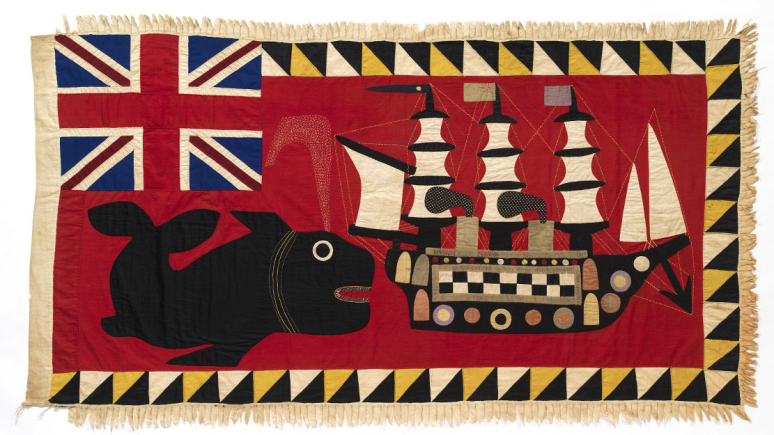A Story of Ghana: Exploring the Asafo Flags at the ROM
Published
Categories
Author
Blog Post
In the modern sense, a flag has a number of meanings that ultimately culminate into being a symbol, representative of some form of pride - pride in one's country or province, or in a particular organization or entity. We fly the flag of our country when we visit other places to tell everyone where we come from, and we face it when we sing our national anthem because it represents the core ideas and values that we sing about. Across the world, flags are perceived in a very similar fashion, but this does not hold true of every place, and it certainly hasn't held true of every time. Enter the Asafo, the fighting companies of modern Akan culture. These groups traditionally fought for the Fante states in modern-day Southern Ghana, and their use of flags transcended our contemporary ideas, becoming an important part of everyday life for the companies that use them.

The size of the fish compared to the ship on this Asafo flag depicts the idea that the natural world is stronger than the contemporary one.
But first, who were the Asafo? In the eighteenth century, traditional Akan groups (the inhabitants of modern-day Southern Ghana), and in particular the Fante states (subgroups of the Akan people), consisted of many small, very independent groups of people. At no point has there ever been a "central state of Fante," so each individual group needed to provide its own protection. The militia groups that defend each state, from threats within and from the outside, are the Asafo. Asafo also participated in cultural events and rituals that reinforced the bonds that held each unique community together. In essence, they were a wide organization of military and community-minded people who kept their state together. At the height of the slave trade in the eighteenth century, Asafo groups formed and used their flags to send messages of resistance and defiance to slavers, and backed up those flags with their fighting power.
A typical Asafo flag is difficult to describe, because there are so many different flags that make up the collection. Asafo flags depict all manner of peoples and events, from simple fish to raging griffons, and each image is highly symbolic. An Asafo flag depicting a crocodile and fish, for instance, was a message to other companies and potential invaders - the invaders were the fish, and the company the crocodile; a beast of prey coming in on a helpless opponent. In a similarly imagery-based message, some companies would depict the traps their people used for bringing home food as a warning that invasion of their territory was a poor idea, by suggesting that invaders would be quickly detected and surrounded. In other cases, flags would bear the image of powerful beasts, such as lions, to intimidate enemies.
Of course, not every company or soldier was of the mindset that everyone and everything was an enemy. A number of flags exist that depict Asafo members winning competitive games, as a kind of banter for rivals and neighbours. Throughout their history, these groups have used wide varieties of flags to depict scenes from historic events, to share advice or wisdom, and even to tell jokes, as well as using them as tools for intimidation.
Another fascinating element of the Asafo flags emerges in the form of those that depict scenes and ideas that would be foreign to the companies. In a way, these flags become a kind of historic record for the companies (especially considering that flags were preserved with particular care). For example, the relative timeline of European influence in Ghana can be recorded fairly well through the observation of images such as dragons and griffons on banners (as neither mythical creature has origins in any African culture). A number of flags also bear marks of Christian influence, adding further evidence to the progression of Christianity as a constant presence in Ghana.
Together, the flags crafted by the Fante states tell a story. As cultural artefacts, they are nothing short of remarkable, and as artistic images, they are excellent at portraying all manner of message, from jokes and insults to historic lessons - and dire warnings as well. A recent talk by the University of Toronto's Professor Ato Quayson explored that story in depth - but you can read it for yourself on the fourth floor of the Museum until February 27th, 2017.


